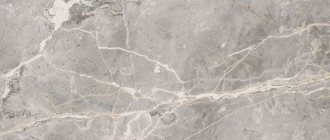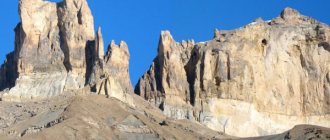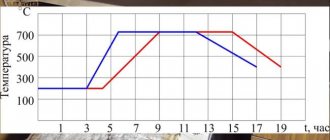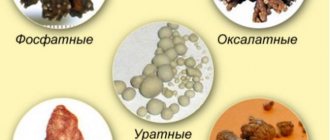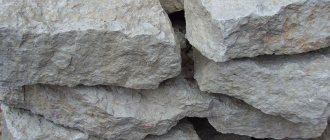Rock is a non-renewable natural resource used in many areas of human life. Houses and structures are built from stones, monuments, decorative slabs and coverings are made. They are used in jewelry, sculpture, architecture and painting. An entire industry was created in order to extract these amazing formations from the depths of the Earth. Based on physical and chemical properties and appearance, you can easily select a material to implement a specific task.
What is a stone
Natural stone is a piece of hard, non-metallic rock formed from one or more minerals through natural processes. The lithosphere, the hard shell of the Earth, consists of a collection of rock layers. There are about 5 thousand varieties of stones, each of which has a different structure, physical and chemical characteristics, and areas of application.
Stone consists of minerals - solid crystalline formations that can mix and transform their structure under the influence of metamorphism. Depending on their composition, stones can be strong or brittle, soft or hard. Some species are located on the surface of the earth, while others lie deep in its depths.
Advantages of natural stone in construction
- Strength. Natural stone is almost impossible to damage. It is highly resistant to mechanical stress.
- Does not react with chemical elements and does not absorb them. That is, it retains its environmental friendliness for the entire time of use.
- Frost resistance. As a natural material extracted from rocks, it can withstand dozens of cycles of freezing and thawing.
- Moisture resistant. Natural stones do not absorb water and are resistant to aggressive liquids.
- Fire resistant. Natural stone is not susceptible to high temperatures.
- Aesthetic appearance. Thanks to its texture, variety and unique color scheme, any design imagination can be realized.
Types of classification of natural stones and minerals
Natural stones and minerals are classified according to their type of origin, composition, hardness, transparency, value and other properties. There are monomineral rocks, consisting of one mineral, and polymineral rocks, consisting of two or more minerals.
In order to distinguish valuable species from decorative ones, various classifications have been compiled. The most relevant of them is the classification of Bauer and Kluge, which includes precious and jewelry stones. The mineralogist Fersman made a significant contribution to its development, adding division into groups and classes.
Other classifications:
- on optical characteristics - compiled by Georg Gurich in 1902;
- at market value - proposed by Evgeny Kievlenko in 1973;
- according to physical and chemical characteristics - created by the All-Union Scientific Research Institute of the Jewelry Industry in the 80s of the 20th century.
Which zodiac signs is it suitable for?
The astrological vector of the influence of flint has been well studied over the long history of mankind’s acquaintance with the durable mineral. The mineral has different effects on all signs of the Zodiac: Aries frees the mind from negative thoughts and strengthens leadership qualities. Taurus protects against problems with the respiratory system. Gemini more honest, add sincerity, and endow it with eloquence. Cancer will be rewarded with success in business and will help cure stomach diseases. Leos will lose the hardships of life and mental pain, and will become more solid. Virgos realize their own potential and strengthen their nerves. Libras determination and help get rid of kidney ailments. Scorpios with a stone in their pocket will increase their influence on people. Sagittarius will be saved not only from prejudices, but also from liver diseases. Capricorn will add attention, sincerity, and ensure career growth. Aquarius will point out people devoted to him and protect him from manifestations of evil. for Pisces to wear a gem - it will increase their aggressiveness.
A stone marked by the influence of Mars is most suitable for signs belonging to the Fire element. This is Aries, Leo, Sagittarius.
Types of stone by origin
The most important criterion for classifying rocks is the type of origin. There are three main methods of stone origin:
- magmatic – primary, or endogenous;
- sedimentary – secondary, or exogenous;
- metamorphic - transformation of igneous or sedimentary rocks under the influence of external factors.
Igneous origin
Rocks of igneous, or endogenous origin, are formed as a result of the solidification of lava. The final structure of the stone depends on its composition, cooling rate and atmospheric factors. There are two types of magmatites:
- Intrusive. Magma gradually solidifies deep underground, putting enormous pressure on the rock. As a result, dense and massive crystallized blocks are formed, practically free of pores and voids.
- Effusive. Lava solidifies on the surface or in the upper layers of the earth through a volcanic eruption, and solidification occurs at low temperatures and occurs unevenly. Such rocks are more fragile and porous, and they often contain cracks.
During the eruption process, hot magma passes through other compounds and dissolves them into itself. According to their chemical composition, igneous rocks are usually divided into:
- acidic - silicon dioxide content more than 65%, with impurities of potassium and sodium;
- medium – 54-65% silicon dioxide, in the presence of aluminum and calcium;
- the main ones are silicon dioxide in the range of 45-54%;
- ultrabasic - less than 45% with a significant content of iron and magnesium.
Sedimentary origin of rocks
A stone of sedimentary or exogenous origin is formed during the destruction of rocks by external factors - atmospheric phenomena, temperature changes. They are found everywhere on the surface of the earth, spreading by currents of air and water. They often accumulate at the bottom of reservoirs, then settle and become compacted. There are the following subspecies:
- clastic – formed from parts of igneous origin;
- biochemical - formed due to the mixing of organic and inorganic compounds;
- chemogenic - consist of deposited sediments of concentrated solutions;
- biogenic - are the ossified remains and waste products of animal and plant origin.
Biogenic and biochemical sedimentary rocks form combustible substances such as coal, shale, peat, and oil.
Metamorphic rock formation
Metamorphic rocks are formed by transformation from other types of rocks. This occurs due to exposure to high temperature, pressure, and chemically active substances. The minerals that made up the primary rock are broken down by factors and then assembled into other compounds that form metamorphic rock. For example, clay, under the influence of metamorphism, turns into shale, and quartz sandstone into quartzite.
Depending on how intense the metamorphic transformation process was, it is not always possible to accurately determine which rock was the primary one. According to the conditions of formation of such rocks, the following types are distinguished:
- Regional. They are formed when lithospheric plates shift, when one mineral rock penetrates deep into another. Accompanied by strong pressure and high temperature.
- Hydrothermal. Occur with the direct participation of underground hot springs. Due to strong heating, the components that make up the rock enter into a chemical reaction and are converted into other compounds.
- Contact. They are formed near intrusive-type magmatites under the influence of high temperature on individual layers of the earth's crust. A distinctive feature of this type of metamorphism is the formation of large mineral crystals of high strength.
Meteorites - space rocks
About two thousand tons of cosmic rock fall to Earth every year. In most cases it consists of silicates such as olifin, fayalite, forsterite, pyroxene, ferrosilite and enstatite. Meteorite formations are predominantly chondriacal in appearance, and their composition is similar to that of the Sun, with the exception of hydrogen and helium. It is likely that rock-type meteorites are formed from the protoplanetary cloud surrounding the Sun through the gravitational attraction of dust and condensation of substances. Used in jewelry and decorative purposes.
A natural stone. Classification
Natural stone is the oldest building material. Due to the complexity of processing, previously it was used to build mainly religious, defensive and palace structures, many of which are considered wonders of the world - Egyptian pyramids, Aztec pyramid, Great Wall of China, Taj Mahal mausoleum... Today's level of development of stone processing allows the use of stone in mass construction – for both external and internal decoration of buildings. But each stone has its own characteristics, which are explained by its physical properties.
Origin and classification of rocks
Stone is one of the rocks. Rocks are natural formations consisting of individual minerals and their associations. The science of petrography studies the composition, origin and physical properties of rocks. According to her data, according to their origin, all breeds are divided into three main groups:
1. Igneous (primary)
2. Sedimentary (secondary)
3. Metamorphic (modified)
Igneous rocks were formed directly from magma (a molten mass of predominantly silicate composition), as a result of its cooling and solidification. Depending on the solidification conditions, deep-seated and extruded rocks are distinguished.
The deep ones arose as a result of the gradual cooling of magma at high pressure inside the earth's crust. Under these conditions, the components of the magma crystallized, resulting in the formation of massive dense rocks with a holocrystalline structure: granites, syenites, labradorites and gabbros.
The erupted rocks were formed as a result of a volcanic eruption of magma, which quickly cooled on the surface at low temperature and pressure. There was not enough time for the formation of crystals, so the rocks of this group have a hidden or finely crystalline structure and high porosity: porphyries, basalts, volcanic tuffs, ash and pumice.
Sedimentary rocks are called secondary because they were formed as a result of the destruction of igneous rocks or from waste products of plants and animal organisms. One of the ways these rocks form is through chemical precipitation that forms as lakes and bays dry out. As a result, various compounds precipitate, which over time turn into travertine and dolomite. A common feature of these rocks is porosity, fracturing, and solubility in water.
Clastic sedimentary rocks include cemented sediments (sandstones, breccias, conglomerates) and loose sediments (sands, clays, gravels and crushed stones). Consolidated sediments were formed from loose ones. For example, sandstone is made from quartz sand with lime cement, breccia is made from cemented crushed stone, and conglomerate is made from pebbles. Other known rocks of organic origin are limestone and chalk. They are formed as a result of the vital activity of animal organisms and plants.
Metamorphic rocks are formed by the transformation of igneous and sedimentary rocks into a new type of stone under the influence of high temperature, pressure and chemical processes. Among the metamorphic rocks, there are massive (granular) ones, which include marble and quartzites, as well as schistose ones - gneisses and schists.
ROCK PROPERTIES
Decorativeness
An important property of rocks that allows them to be used as a facing material is decorativeness. This refers to the aesthetic appeal of natural stone, primarily its color and pattern.
Strength
If we talk about the use of natural stone in construction, then in this sense one of its most important properties is strength, on which the wear resistance of the material depends. The stronger the stone, the longer it will last.
Depending on the hardness of the minerals that make up the rock and largely determine its properties, stones are conventionally divided into three groups:
– durable – quartzites, granites, gabbro;
– medium strength – marble, limestone, travertine;
– low strength – loose limestones, tuffs.
Density Density is the mass of a unit volume of a substance. The weight of the structure depends on this indicator: the higher the density of the stone, the heavier the structure will be. By density, stones are divided into light (density up to 2200 kg/m3) and heavy (density more than 2200 kg/m3). Density depends on the porosity of the rock and the minerals included in its composition.
Porosity
The porosity of the stone, which is used as a facing material, is one of its most important characteristics. Water absorption and, accordingly, salt and acid resistance depend on porosity. And these are the main indicators that affect the durability of the material. In addition, the total porosity determines the strength, thermal conductivity, polishability, workability, decorativeness of the stone and other quality characteristics. With an increase in overall porosity, the strength and volume of the stone decreases, its polishability deteriorates, but the weight of the product decreases and its ability to be processed improves.
Water absorption, salt, acid and frost resistance
Another important property of rocks associated with porosity is the water absorption rate. The acid and salt resistance of the stone, as well as its frost resistance, depend on it and on the mineral composition of the material. After all, when freezing, the water in the pores increases in volume by 9%, creating powerful pressure. Water, penetrating into the pores of materials, leaves concentrated solutions of salts on them after drying. Crystals begin to grow from them, creating enormous crystallization pressure. With high water absorption and low porosity, cracks form in the material under this pressure. With high porosity of the stone, the crystallization pressure is distributed evenly, and new cracks do not form (a striking example is limestone). Acid resistance is the ability of rocks and materials to react with various acids, destroying or transforming rocks. Marble reacts to acids, including food acids (citric, acetic). Marble, travertines, limestones and dolomites are destroyed by hydrochloric acid. True, it does not occur in nature in free form, but in cities where chlorides are used to combat snow, this risk factor increases significantly.
All this means that in the exterior decoration of buildings it is better to use rocks that do not collapse under the influence of adverse factors and retain their appearance for a long time, for example, granite and limestone. Limestone is good for basement structures. It is not without reason that in all large cities located in river valleys and with a centuries-old history (London, Paris, Cologne, Moscow), all the plinths of buildings are made of limestone. In Moscow, by the way, the base of the walls and towers of the Moscow Kremlin is made of limestone. Granite can also be used for the base, but in this case the movement of salts will occur along the masonry joints.
Classification of rocks by degree of abrasion
| Abrasion group | Species and materials | Natural wear and tear with a human traffic intensity of 1 million people. per year (mm) |
| 1 | Quartzites and granite group rocks | less than 0.12 |
| 2 | Basalts, microcrystalline marble | 0,12-0,35 |
| 3 | Loose basalts, marble, sandstones, dolomites | 0,35-0,6 |
| 4 | Marbled limestones, travertines, limestones, tuffs | 0,6-1,5 |
| 5 | Loose limestones | 1,5-2,5 |
Intensity of human flow
| Object of material use | Number of people per year |
| Transport arteries (metropolitan, train stations) | 4 million people |
| Supermarkets, transition zones, passages, stadiums | 1 million people |
| Public buildings (shops, schools, institutes) | 500 thousand people |
| Hotels, theaters | 200 thousand people |
| Entrances of high-rise buildings | 100 thousand people |
| Personal apartments | 20 thousand people |
Textured stone surface treatment
To give the stone additional aesthetics, it is subjected to various texture treatments, which can reveal and emphasize the decorative properties of the stone or, conversely, obscure them. In the process of such processing, the front part of the stone slab is processed with various tools, creating a decorative relief.
Texture "Rock". The rough relief of the stone is obtained as a result of chipping large pieces from the workpiece. The result is a natural chipping of the stone with differences in relief heights of up to 5 - 15 cm. This texture is performed both mechanically and manually.
Dot texture. Smooth surface with pinholes.
Sawn texture. Achieved by processing the stone with diamond circular saws. The result is a rough surface with longitudinal grooves and height differences of up to 5 mm.
Heat treatment. Under the influence of a high-temperature gas jet, the surface of the stone becomes rough, with traces of peeling and a well-defined structure. Height difference – up to 5 mm.
Polished texture. A smooth, slightly rough surface of a stone with traces of processing with an abrasive tool. Height difference – 2 mm. The pattern, color and structure of the stone appear weakly in this case, but the overall background becomes lighter.
Polished texture. Smooth matte surface without visible traces of processing with an abrasive tool, with a clearly defined stone pattern.
Polished texture. Sometimes the polishing process is also called gloss rolling, since this texture is characterized by a mirror-like surface shine. The smooth surface of the stone clearly reflects the details of objects. Polishing fully reveals and emphasizes the natural color and pattern of the stone.
APPLICATION OF ROCKS
Granites
Granite (from the Latin “granum” - grain) is the most common rock. It has a pronounced granular-crystalline structure and consists mainly of feldspars, quartz, mica and other minerals. Based on the size of the grains, granites are divided into fine-grained, medium-grained, and coarse-grained. The color palette of granite is extremely rich. Most often, gray granite is found in different shades - from light to dark. There are also pink, orange, red, bluish-gray and sometimes bluish-green granite. Granites with blue quartz are extremely rare. The following varieties of granites are considered the most decoratively valuable: fine-grained light gray with a blue tint, deep dark red and greenish-blue. Granite is well polished, maintaining a mirror-like surface shine for a long time, and is easy to carve, which allows you to create various textures. To create decorative effects, some types of granites are subjected to heat treatment. Light gray granites then acquire a delicate sugar-white hue.
Due to its high mechanical properties and performance properties, granite is widely used in the construction of basement structures, cladding embankments, building facades, and floors in areas with large human traffic. Fine-grained granite is used in sculpture (since its structure allows impact processing), and coarse-grained granite is used for the construction of monumental structures. Very often, granites include syenites, which differ from granites in less pronounced grain size and the absence of quartz (due to this they are better processed). Syenites are darker than granites: they usually have gray, dark gray, gray-blue, dark pink colors. They are used in construction in the same way as granites.
Gabbro
Gabbro is a deep-seated granular-crystalline rock. It has the same structure as granite: fine-, medium- and coarse-grained. It is characterized by increased viscosity and resistance to weathering. There is no quartz in gabbro, so the stone is easy to machine, polishes very well and retains its surface shine for a long time. Gabbro comes in color shades from dark gray-green to black. Due to some transparency of plagioclase, the polished surface of the stone acquires a well-defined depth, which distinguishes gabbro from other black rocks. For example, from basalt. The combination of polished black and light gray chipped gabbro, which is used to create designs and ornaments, looks quite impressive. Fine-grained greenish-black and black gabbro is usually used as facing material. Gabbro tolerates frost well. Therefore, it is widely used for cladding facades, finishing public buildings, creating monumental structures, and less often in private interiors. Gabbro floors will quickly lose their polish in high traffic areas.
Labradorites
The name of this stone was given by the Labrador Peninsula, where it was first discovered. Labradorite is a deep-seated granular-crystalline rock, the main component of which is labradorite plagioclase. There are two types of labradorites: black and gray. Black labradorites are more common.
A special decorative effect is given to this stone by shimmering rainbow spots on the surface: blue-green, cornflower blue, golden yellow, red shades. Stones in blue, blue and greenish tones increase the decorative value of the rock. Labradorite is most often used in polished form. The stone has high strength and frost resistance, which allows it to be successfully used in the exterior decoration of buildings. But it is also used indoors - for cladding floors, wall plinths, and columns. By the way, black labradorite was used in the construction of the Cathedral of Christ the Savior in Moscow in 1851.
Sandstones
Sandstone is a sedimentary rock consisting of cemented sand. The most durable are siliceous sandstones. Sandstones come in grey, green, red, yellow, brown and brown colours. Fine-grained red, chocolate brown and green varieties of sandstone, which are successfully used for exterior cladding, are considered decorative. Moscow and St. Petersburg buildings built in the 19th – early 20th centuries have well-preserved cladding made of Polish sandstone in grey-green, yellow and pink shades. And the Cathedral Square of the Moscow Kremlin is lined with Lyubertsy sandstone.
However, sandstone is a rather porous material, so it is not advisable to use it for finishing elements in contact with water (primarily we are talking about basement structures). Sandstones cannot be polished, so the most popular sandstone textures are chipped, sawn, and sometimes polished textures.
Limestones
This is a rock of organic and organo-chemical origin, consisting mainly of calcite, often with an admixture of quartz, clay and sand particles. Often contains remains of calcareous skeletons of fossil organisms. Limestones are white, light gray, yellowish, and less often pinkish in color. White limestones with yellow and pink tints are considered the most valuable in a decorative sense. Depending on its structure, limestone is divided into dense, porous and marble-like. Dense limestones are used in the manufacture of slabs for external and internal cladding. These include, in particular, the famous Myachkovsky, Korobcheevsky and Kovrovsky limestones, from which Russian architects built wonders of white-stone architecture. Frost-resistant varieties are also found in the limestone group. To be convinced of this, just look at the perfectly preserved buildings of the 13th – 14th centuries. Among porous limestones, several varieties are also distinguished. For example, oolitic limestones have a coarse-grained structure with rounded calcite formations. They are usually used as a building material for walls, less often for cladding facades. Shell limestones (shell rocks) are rather porous rocks, consisting of mollusk shells and their fragments, held together with lime cement. Some types of shell rocks are considered decorative: for example, pure white, pink, golden yellow with a large content of shells. Shell rocks can be easily processed with a cutting tool, and some types can even be polished (though without obtaining a decorative shine). Shell rocks are widely used as a building material for walls, as well as for external and internal cladding of buildings.
Marble
The name “marble” comes from the Greek “marmaros”, which means shiny. This granular crystalline rock resulted from the recrystallization of limestone and dolomite under the influence of high temperature and pressure. But in construction, the word “marble” refers not only to this stone, but also to other rocks similar to it. For example, marble-like limestones and dolomites. The vast majority of marble lends itself well to processing with any tools, which allows you to expand the already rich range of its colors. For example, polishing enhances the pattern and color of marble, polishing reduces its brightness and clarity, and the texture of chipping completely hides the pattern, but significantly brightens the overall background. Although this can be applied to any stone. Based on decorative properties, processing capabilities and breadth of application, marble is divided into white, gray and colored.
White marble contains practically no impurities, so it is often homogeneous and has a fine- and medium-grained structure. This marble is easy to process. The most valuable is considered to be fine-grained white marble, which is famous for its warm tone and the fact that it is translucent. This stone is also called statue stone, as it is widely used in sculpture. White marble is considered a very capricious home stone, which is due to its special structure: it is poorly protected from staining and yellowing. This applies primarily to inexpensive varieties. Such marble should be used with caution when cladding facades. Of course, its technical characteristics allow it to survive both severe frosts and mechanical damage, but after some time it may lose its beauty and shine, become dull and covered with yellow spots. Gray marble is most often heterogeneous and has layered colors. The characteristic pattern of gray marble is “cloudy” and “snowy landscape”. This type of marble is easy to process and polish. It, like white marble, is used for external and internal cladding. Among colored marbles, blue-blue varieties are considered rare. All of them lend themselves well to polishing. The heat-resistant qualities of marble make it possible to use this stone for external cladding of fireplaces or rooms associated with high temperatures. The water absorption coefficient of marble, like that of granite, is quite low, so it can be used in the construction of pools, bathtubs and fountains. But it is best to decorate interiors with marble.
Quartzite
These are fine-grained rocks that were formed during the recrystallization of siliceous sandstones and consist mainly of quartz. They come in grey, pink, yellow, crimson red, dark cherry and sometimes white. Quartzite is considered a very beautiful stone, especially its crimson-red and dark cherry varieties. The chipped texture significantly brightens the overall background of the stone, which is often used by combining it with the contrasting color of the polished texture. Quartzite has a very high hardness and is a difficult-to-cut material, but can be polished to a very high quality.
This stone is used in monumental art and in the construction of unique architectural structures (for example, in the construction of the Church of the Savior on Spilled Blood). In addition, for many centuries, quartzite was also used as a ritual stone: the sarcophagus of Napoleon, Alexander II, and the upper part of the Lenin Mausoleum were made from it.
Slate
This dense and hard rock was formed mainly from highly compacted clay, which partially recrystallized under high unilateral pressure. A characteristic feature of slates is their ability to split into thin plates. Colors: dark grey, black, taupe, red-brown. Slate is a fairly durable material, it can be processed (it is laminated into thin plates), some types can be polished. However, slates are often used without any treatment at all, because their surface at the site of the split is itself quite decorative. Slate is used in external and internal cladding of walls and floors. For example, the floors of St. Isaac's Cathedral in St. Petersburg are partially made of slate. In Europe, they often cover the roofs of houses.
Semiprecious stones
These include mainly rocks, which are also called decorative and ornamental stones: jasper, onyx , opal, malachite, lapis lazuli. These stones are much rarer and are valued much more than others. It is quite expensive to cover large surface areas with them, so most often small interior elements are trimmed with semi-precious stones: details of columns, window sills, bathrooms, as well as mosaic fragments. Onyx (translated from Greek as “nail”) is considered one of the most common decorative and ornamental stones. Onyxes have a layered or radical-radiant structure. There are white, light yellow, yellow, brown, dark brown, pale green colors. The pattern alternates stripes of different shades. Most marble onyxes are translucent, sometimes to a depth of 30–40 mm. Onyx can be easily processed with cutting and grinding tools and can be polished with high quality. A striking example of the use of onyx in interior decoration is the stained glass windows at the Dynamo metro station in Moscow.
WHAT PROBLEMS CAN ARISE WITH STONE COVERING
Yellowing is primarily a problem with all light-colored marbles. Some types of marble, such as Koelga, may turn yellow on their own, especially if the external environment contributes to this (frost, temperature changes). Marble, unlike granite, is considered a very capricious home stone, so it should be used with caution when cladding facades. The appearance of a yellow spot may have another, “mechanical” reason. For example, if during laying some metal object (for example, a nail) accidentally got into the concrete screed. When exposed to water and air, it may begin to rust. This process will immediately be reflected on the marble slab - because stains show up well on marble. Unfortunately, this area of the marble slab cannot be cleaned. To prevent marble from yellowing, it must be laid on white adhesives. In the kitchen, marble cladding should be used carefully, especially if the countertop is made of marble. If you still cannot do without a marble countertop, it must be protected with hydrophobic chemical compounds. Tarnishing occurs mainly in polished marbles laid on the floor. Over time, the shiny polish of marble wears off, giving way to a dull roughness. Marble is more susceptible to abrasion than, for example, granite. Therefore, polished marble is not recommended for installation in areas of heavy traffic: in the hallway, hall, and the like. To prevent marble from tarnishing, you can use polished and waxed stone from the very beginning. The situation here is the same as with a wooden floor. If you cover it with varnish, it will wear off over time, and to restore the appearance you will need to remove the old varnish and apply a new one. If the wood is coated with wax, then later after applying special products it easily restores its shine. It's the same with marble. Tarnished polished marble floors require repolishing, while waxed marble only needs to be re-coated with a special compound. The shine is deeper and more matte, not as mirror-like as when polished. In addition, polished marble absorbs water, and waxing creates a hydrophobic protection.
Strong slip is a property of polished granite laid outdoors (on a porch, on stairs) or on the floor. The sliding coefficient of granite with this type of processing is very high.
If we add to this weather conditions such as rain or snow, then walking on a polished surface becomes dangerous. Therefore, it is not recommended to use polished granite outdoors without anti-slip strips applied using corundum or heat treatment.
CARE OF NATURAL STONE
Now there are various chemical agents that allow you to preserve the natural color and shine of natural stone longer. Using a special putty mixture, selected according to color, you can eliminate the smallest cracks and pores on the surface of the stone that form during its mechanical processing. This will protect the lining from microorganisms getting there. Depending on the area of application of the stone, it is treated with a water- or dirt-repellent composition. In addition, there are means for ongoing care of stone products. Let's say, mild cleaning shampoos for daily care and for one-time use (for example, to remove stains). Special polishes add shine to polished surfaces, anti-spatter agents reduce the risk of stains on stone cladding, and various protective substances prevent scratches and other mechanical damage. These, of course, are not all chemical compounds intended for stone care. In fact, there are many more of them.
The article was first published in the Tile and Stone catalog in 2001. The “Tile and Stone” catalog is a supplement to the “Designer and Architect Library” of the “Stool” magazine.
Rocks and minerals: features and differences
A rock is made up of the minerals that form it. Depending on the conditions of formation, a rock may contain one or more minerals, and its properties depend entirely on the components. Minerals, on the other hand, have a more uniform structure and consist of crystals with a symmetrical structure; their properties depend on the type of mineral.
Features of rocks:
- heterogeneous substances that form the earth's crust;
- formed from minerals;
- divided by type of origin;
- used in architecture, design, and decorative purposes.
Features of minerals:
- homogeneous substances that make up rocks;
- differ in physical and chemical properties;
- used in industry, agriculture and high-tech industries.
Use of limestone
Limestone is a universal material that has found application in manufacturing, agriculture, construction, and interior design. The scope of use of the stone varies depending on its origin, physical characteristics, and composition. The main areas of use of limestone:
- Construction. Some types of limestone are strong enough to be used for low-rise buildings, but in most cases the material is used as cladding. It is used to make wall panels, facing slabs, and decorative elements - columns, pilasters, bas-reliefs. Small fractions of stone are used as crushed stone in the production of concrete, while large fractions are used for arranging the foundations of highways and hydraulic structures. Rubble stone (large fragments up to 500 mm in size) is suitable for foundation work.
- Finishing and cladding. Limestone is a popular façade material that withstands Russian climatic conditions well. Thin sections of wear-resistant stone are a ready-made material for laying garden paths and sidewalks.
- Interior design. Marbled limestone of rare shades is used for finishing walls, stairs, floors, making kitchen countertops, window sills, and bar counters. The stone of exquisite colors is suitable for creating fireplace portals, coffee tables, and decorative columns. Among designers, layered stone with a pronounced relief is especially valued.
- Production of finishing materials. Whitewash, paint, and putty are made from limestone.
- Production of cement. Carbonate components in the raw material mixture for cement production can reach 80% of the total volume of raw materials. Along with limestone, clay, slag, and corrective additives are added to cement.
- Chemical industry. The material is used in technologies for the production of plastic, rubber, and pharmaceuticals.
- Production of sugar, glass, soda. Here the mineral is used as an additional raw material. For example, in the production of sugar, lime is used, obtained by burning carbonate rocks.
- Metallurgy. Limestone is an indispensable component in metal smelting. Limestone flux lowers the melting point and makes it easier to separate the metal from the gangue. Used with ores rich in silica and alumina.
In addition, limestone is actively used as a component of toothpastes and shoe creams, in the production of filters and mineral fertilizers. The mineral is also used in paper production - about 800 kg of finished products can be obtained from one ton of material. Some types of limestone are used in the production of abrasives for fine grinding, and in agriculture it is used as a mineral additive for livestock and poultry.
Limestone is important not only for finishing buildings and interiors. It is indispensable in the creation of cement, and is also used in other industries, such as sugar refining and glass production. When limestone is heated, it is used in the production of iron and steel, as well as alumina and magnesia. Limestone also helps purify drinking water. Farmers often use fertilizer that contains crushed limestone on crops. Limestone in the mixture is a source of nutrients and neutralizes soil acidity. Powdered limestone is used to remove impurities from cast metals. Limestone is used as a filler in a variety of products, including paper, plastics and paint. The purest limestone is even used in foods and medicines such as calcium tablets and breakfast cereals.
Natural natural stones and their areas of application in construction, architecture, design
Natural stones are used in many areas of life. Granite, mica, slate and labradorite are used in construction and facing work, and flint, mirabilite and gypsum are used in medicine. The development of sculptural art and painting would have been impossible without marble, cinnabar and graphite, and agriculture would not have been able to function without limestone. Diamonds, sapphires and quartz are used in instrument making. These and many other types are used in architecture, design, decorative and jewelry purposes.
Marble
Marble is a metamorphic rock consisting primarily of calcite and admixtures of organic compounds. Easily processed. The stone comes in various colors, thanks to which it is successfully used in sculptural art, the furniture industry, and interior cladding. The disadvantages of marble include high cost and vulnerability to acidic environments.
Marble
Granite
Granite is an igneous hard stone of acidic type, replete with various colors and patterns. Composed of quartz, plagioclase, potassium spar and biotite and/or muscovite. Resistant to adverse environmental factors. It is used for cladding walls and slabs, making monuments, and building roads. The disadvantage of the material is its significant weight, which requires additional measures when working with it.
Granite
Limestone
Limestone is a sedimentary rock of biogenic, sometimes chemogenic origin, consisting of calcium carbonate. It is formed in large quantities at the bottom of oceans and seas. Limestone is used to make tiles and crushed stone, and limestone blocks are used in the construction of buildings. Eco-friendly, easy to process. The disadvantages are low moisture resistance and low load-bearing capacity.
Marly limestone
Pelitomorphic limestone
Sandstone
Sandstone is a sedimentary rock of clastic type, consisting of sand grains bound by mineral matter. It is almost as hard as granite. Depending on the color, it is used for decorative purposes; it is also used for the production of facing tiles and pouring foundations. Quartz sandstone is used to make glass. Disadvantages include heavy weight and lack of hygiene.
Feldspar-quartz sandstone
Quartz sandstone
Slate
Shales are rocks with a layered arrangement of minerals such as chlorite, actinolite, serpentine, quartz and muscovite. It is a product of volcanic activity. Physical properties depend on the composition. Various types of slates are used for the production of sand-lime bricks, crushed stone, cladding, and asphalt. Disadvantages of slates: dull color palette, high cost, heavy weight. Falls apart when subjected to physical impact.
Crystalline garnet-two-pyroxene schist
Crystalline shale hypersthene-plagioclase
Travertine
Travertine, or calcareous tuff, is a fine-grained rock formed from calcium carbonate. It is distinguished by its low weight and hardness, porous structure. Travertine tiles are used for both interior and exterior decoration. Also used for liming soil in agriculture. The disadvantages include the fact that it requires careful and regular care.
Travertine
Basalt
Basalt is a basic type of igneous rock consisting of plagioclase, clinopyroxene, magnetite and volcanic glass. Can change its structure due to hydrothermal processes. It is characterized by high strength and ductility, which allows the use of basalt in the production of insulating materials, slabs and mineral sheets. It is the most common igneous rock. The disadvantages include the high price.
Basalt
Basalt
Labradorite
Labradorite is an igneous intrusive rock of the main type, consisting of plagioclase - labradorite with admixtures of pyroxenes and ore minerals. High-quality facing stone, used for decorative purposes and monumental architecture. It has high strength and weather resistance. The disadvantage is the high cost.
Labradorite
Flint
Flint is a sedimentary rock with high hardness. It is a type of quartz, consisting of crystalline and amorphous silica. Able to change color when mixed with other rocks. At the dawn of mankind, it was used for striking fire and making tools. Currently used for road construction and decorative purposes. There are no disadvantages.
Flint
Flint
Flint
What is limestone
Limestone is a sedimentary rock, during the formation of which a porous stone of varying density and shade is formed with an abundance of calcite (lime spar). The structure of the material also includes other minerals that reduce its porosity and increase its strength. Limestones are deposited mainly in salty sea basins, less often - during the evaporation of lagoons and lakes. The color of limestones is predominantly light gray, beige, and yellowish. The presence of organic, ferrous, manganese and other impurities causes dark gray, brown, reddish and greenish coloring.
As a rule, the origin of limestone is associated with the vital activity of organisms that secrete calcium carbonate from salt water to form skeletons and shells. Less commonly, the material is of chemogenic origin. Subsidence of rock lasts millions of years (modern strata remained after the drying of ancient seas). The thickness of the limestone deposits is radically different: from a few centimeters to five kilometers. The younger the deposits are, the looser the rocks are.
